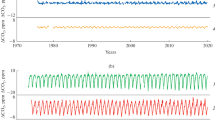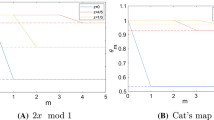Abstract
Much of the current interest in pollen time series analysis is motivated by the possibility that pollen series arise from low-dimensional chaotic systems. If this is the case, short-range prediction using nonlinear modeling is justified and would produce high-quality forecasts that could be useful in providing pollen alerts to allergy sufferers. To date, contradictory reports about the characterization of the dynamics of pollen series can be found in the literature. Pollen series have been alternatively described as featuring and not featuring deterministic chaotic behavior. We showed that the choice of test for detection of deterministic chaos in pollen series is difficult because pollen series exhibit \(1/f^{\alpha }\) power spectra. This is a characteristic that is also produced by colored noise series, which mimic deterministic chaos in most tests. We proposed to apply the Ikeguchi–Aihara test to properly detect the presence of deterministic chaos in pollen series. We examined the dynamics of cedar (Cryptomeria japonica) hourly pollen series by means of the Ikeguchi–Aihara test and concluded that these pollen series cannot be described as low-dimensional deterministic chaos. Therefore, the application of low-dimensional chaotic deterministic models to the prediction of short-range pollen concentration will not result in high-accuracy pollen forecasts even though these models may provide useful forecasts for certain applications. We believe that our conclusion can be generalized to pollen series from other wind-pollinated plant species, as wind speed, the forcing parameter of the pollen emission and transport, is best described as a nondeterministic series that originates in the high dimensionality of the atmosphere.



Similar content being viewed by others
References
Aizawa Y, Kohyama T (1984) Asymptotically non-stationary chaos. Prog Theor Phys 71:847–850
Arizmendi CM, Sanchez JR, Ramos NE, Ramos GI (1993) Time series predictions with neural nets: application to airborne pollen forecasting. Int J Biometeorol 37:139–144
Bianchi MM, Arizmendi CM, Sanchez JR (1992) Detection of chaos: new approach to atmospheric pollen time-series analysis. Int J Biometeorol 36:172–175
Casdagli M (1991) Chaos and deterministic versus stochastic non-linear modelling. J R Stat Soc Ser B Stat Methodol 54:303–328
Delaunay J-J, Fedra K, Kubat M (2002) Cedar pollen forecasting in the Kanto region. Arch Complex Environ Stud 14:34
Delaunay J-J, Seymour C, Fouillet V (2004) Investigation of short-range cedar pollen forecasting. Phys Rev E 70 (doi 066214)
Grassberger P, Procaccia I (1983) Characterization of strange attractors. Phys Rev Lett 50:346–349
Ikeguchi T, Aihara K (1997) Difference correlation can distinguish deterministic chaos from \(1/f^{\alpha }\) type colored noise. Phys Rev E 55:2530–2538
Kawashima S, Takahashi Y (1995) Modeling and simulation of mesoscale dispersion processes for airborne cedar pollen. Grana 34:142–150
Kawashima S, Takahashi Y (1999) An improved simulation of mesoscale dispersion of airborne cedar pollen using a flowering-time map. Grana 38:316–324
Osborne AR, Provenzale A (1989) Finite correlation dimension for stochastic systems with power-law spectra. Physica D 35:357–381
Takens F (1981) Detecting strange attractors in fluid turbulence. In: Rand DA and Young LS (eds) Dynamical systems and turbulence, Springer, Berlin Heidelberg New York
Uhlenbeck GE, Ornstein LS (1930) On the theory of the Brownian motion. Phys Rev 36:823–841
Wolf A, Swift JB, Swinney HL, Vastano JA (1985) Determining Lyapunov exponent from a time series. Physica D 16:285–317
Yamato Corporation (1998) Japanese patent number 10–318908
Acknowledgements
We are very grateful to Toshitaka Yokoyama of the Forestry and Forest Products Research Institute of Japan and Yuichi Takahashi of the Yamagata Prefecture Institute of Public Health for providing the pollen series.
Author information
Authors and Affiliations
Corresponding author
Rights and permissions
About this article
Cite this article
Delaunay, JJ., Konishi, R. & Seymour, C. Analysis of cedar pollen time series: no evidence of low-dimensional chaotic behavior. Int J Biometeorol 50, 154–158 (2006). https://doi.org/10.1007/s00484-005-0004-9
Received:
Revised:
Accepted:
Published:
Issue Date:
DOI: https://doi.org/10.1007/s00484-005-0004-9




